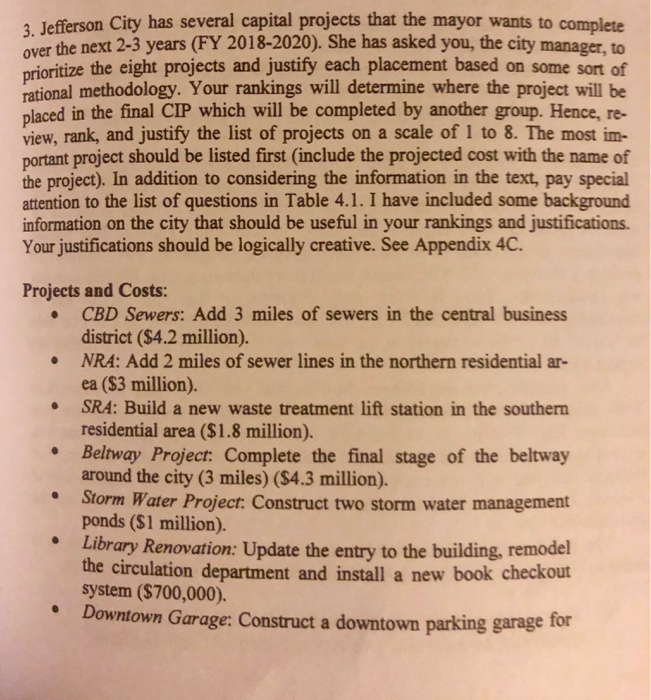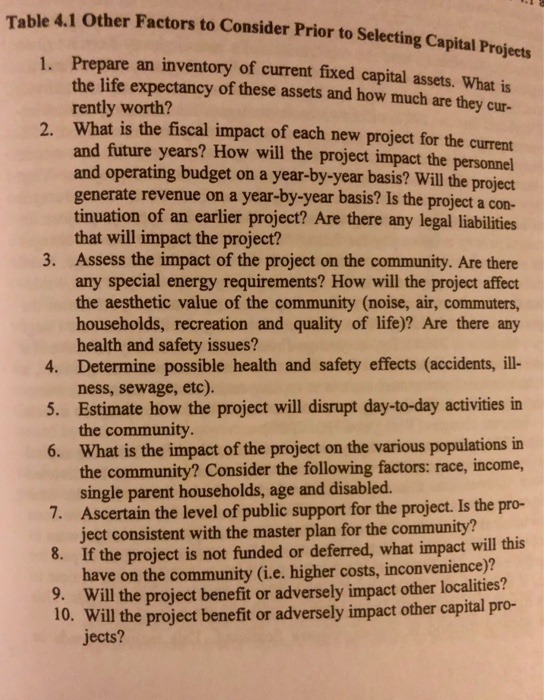to be done in Excel format

y each placine where the oup Jefferson City has several capital projects that the mayor wants to complete over the next 2-3 years (FY 2018-2020). She has asked you, the city manager to prioritize the eight projects and justify each placement based on some sort of rational methodology. Your rankings will determine where the project will be placed in the final CIP which will be completed by another group. Hence, re- view, rank, and justify the list of projects on a scale of 1 to 8. The most im- portant project should be listed first (include the projected cost with the name of the project). In addition to considering the information in the text, pay special attention to the list of questions in Table 4.1. I have included some background information on the city that should be useful in your rankings and justifications. Your justifications should be logically creative. See Appendix 4C. Projects and Costs: CBD Sewers: Add 3 miles of sewers in the central business district ($4.2 million). NRA: Add 2 miles of sewer lines in the northern residential ar- ea ($3 million). SRA: Build a new waste treatment lift station in the southern residential area ($1.8 million). Beltway Project: Complete the final stage of the beltway around the city (3 miles) ($4.3 million). Storm Water Project: Construct two storm water management ponds ($1 million). Library Renovation: Update the entry to the building, remodel the circulation department and install a new book checkout system ($700,000). Downtown Garage: Construct a downtown parking garage for 102 Chapter Four city employees and public use ($2.5 million), Downtown Artery: Landscaping the main downto ($800,000). downtown artery Background Information: The population of the city has grown an average of 40% for the last 5 years. The number of public service employees has increased an erage of 2% a year for the last 10 years. Ten new corporations have moved into the city over the last three years employing 2770 new employees. Roughly half of them are located in the southern region and the other half in the northern region. However, those in the southern region tend to be more dependent upon water given the nature of the business. The city has 98,000 residents and lies in between two large cities exceeding 1 million residents. The land selected for the construction of the ponds is located near a school and a public park. The average household income in the city is $60,000 per year. be 4.1 Other Factors to Consider Prior to Selecting Capital Proiecte 1. Prepare an inventory of current fixed capital assets. What is the life expectancy of these assets and how much are they cur- rently worth? What is the fiscal impact of each new project for the current and future years? How will the project impact the personnel and operating budget on a year-by-year basis? Will the project generate revenue on a year-by-year basis? Is the project a con- tinuation of an earlier project? Are there any legal liabilities that will impact the project? 3. Assess the impact of the project on the community. Are there any special energy requirements? How will the project affect the aesthetic value of the community (noise, air, commuters, households, recreation and quality of life)? Are there any health and safety issues? Determine possible health and safety effects (accidents, ill- ness, sewage, etc). Estimate how the project will disrupt day-to-day activities in the community. 6. What is the impact of the project on the various populations in the community? Consider the following factors: race, income, single parent households, age and disabled. 7. Ascertain the level of public support for the project. Is the pro- ject consistent with the master plan for the community? 8. If the project is not funded or deferred, what impact will this have on the community (i.e. higher costs, inconvenience)? 9. Will the project benefit or adversely impact other localities? 10. Will the project benefit or adversely impact other capital pro- jects? 5. y each placine where the oup Jefferson City has several capital projects that the mayor wants to complete over the next 2-3 years (FY 2018-2020). She has asked you, the city manager to prioritize the eight projects and justify each placement based on some sort of rational methodology. Your rankings will determine where the project will be placed in the final CIP which will be completed by another group. Hence, re- view, rank, and justify the list of projects on a scale of 1 to 8. The most im- portant project should be listed first (include the projected cost with the name of the project). In addition to considering the information in the text, pay special attention to the list of questions in Table 4.1. I have included some background information on the city that should be useful in your rankings and justifications. Your justifications should be logically creative. See Appendix 4C. Projects and Costs: CBD Sewers: Add 3 miles of sewers in the central business district ($4.2 million). NRA: Add 2 miles of sewer lines in the northern residential ar- ea ($3 million). SRA: Build a new waste treatment lift station in the southern residential area ($1.8 million). Beltway Project: Complete the final stage of the beltway around the city (3 miles) ($4.3 million). Storm Water Project: Construct two storm water management ponds ($1 million). Library Renovation: Update the entry to the building, remodel the circulation department and install a new book checkout system ($700,000). Downtown Garage: Construct a downtown parking garage for 102 Chapter Four city employees and public use ($2.5 million), Downtown Artery: Landscaping the main downto ($800,000). downtown artery Background Information: The population of the city has grown an average of 40% for the last 5 years. The number of public service employees has increased an erage of 2% a year for the last 10 years. Ten new corporations have moved into the city over the last three years employing 2770 new employees. Roughly half of them are located in the southern region and the other half in the northern region. However, those in the southern region tend to be more dependent upon water given the nature of the business. The city has 98,000 residents and lies in between two large cities exceeding 1 million residents. The land selected for the construction of the ponds is located near a school and a public park. The average household income in the city is $60,000 per year. be 4.1 Other Factors to Consider Prior to Selecting Capital Proiecte 1. Prepare an inventory of current fixed capital assets. What is the life expectancy of these assets and how much are they cur- rently worth? What is the fiscal impact of each new project for the current and future years? How will the project impact the personnel and operating budget on a year-by-year basis? Will the project generate revenue on a year-by-year basis? Is the project a con- tinuation of an earlier project? Are there any legal liabilities that will impact the project? 3. Assess the impact of the project on the community. Are there any special energy requirements? How will the project affect the aesthetic value of the community (noise, air, commuters, households, recreation and quality of life)? Are there any health and safety issues? Determine possible health and safety effects (accidents, ill- ness, sewage, etc). Estimate how the project will disrupt day-to-day activities in the community. 6. What is the impact of the project on the various populations in the community? Consider the following factors: race, income, single parent households, age and disabled. 7. Ascertain the level of public support for the project. Is the pro- ject consistent with the master plan for the community? 8. If the project is not funded or deferred, what impact will this have on the community (i.e. higher costs, inconvenience)? 9. Will the project benefit or adversely impact other localities? 10. Will the project benefit or adversely impact other capital pro- jects? 5










